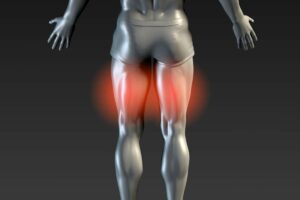Do you have a hamstring injury that just won’t go away? If so, you may need to seek the help of a physical therapist. A physical therapist can help you heal your hamstring injury using a variety of techniques, including massage, stretching, and electrical stimulation. In this blog post, we will discuss how physical therapy can help you heal your hamstring injury quickly and effectively. We will also provide some tips on how to find the best physical therapist for you!
Contents
What Is A Hamstring?
 The hamstring, also called the leg biceps, is a group of three muscles on the back of your thigh. They all work together to help you bend and extend your knee as well as straighten your hip while flexing at the same time. Hamstring injuries are a common complaint in many sports where people frequently experience injury from overstretching or tears in the muscle. Whether you have a minor injury such as a strain, or something more severe like a hamstring tear, it is important to know how physical therapy can help you heal from your injuries and get back to doing what you love.
The hamstring, also called the leg biceps, is a group of three muscles on the back of your thigh. They all work together to help you bend and extend your knee as well as straighten your hip while flexing at the same time. Hamstring injuries are a common complaint in many sports where people frequently experience injury from overstretching or tears in the muscle. Whether you have a minor injury such as a strain, or something more severe like a hamstring tear, it is important to know how physical therapy can help you heal from your injuries and get back to doing what you love.
How To Know If You Have Pulled A Hamstring?
If you have a hamstring injury, you may experience a lot of pain and discomfort in your leg. You may feel a pull or tear in the muscle, which can make it difficult to walk or move around normally. Other common symptoms include stiffness, swelling, and tenderness in the area. Depending on the severity of your injury, you may need to see a doctor, physical therapist, or other healthcare professional. In some cases, you may have to leave work or reduce your athletic activity until the injury heals.
When Should I Start Hamstring Physical Therapy?
 Hamstring physical therapy should be one of the first things you consider if you’ve been diagnosed with a hamstring injury. There are many different options when it comes to treatment, and you may find that physical therapy is an effective way to reduce your pain and regain general function in your leg.
Hamstring physical therapy should be one of the first things you consider if you’ve been diagnosed with a hamstring injury. There are many different options when it comes to treatment, and you may find that physical therapy is an effective way to reduce your pain and regain general function in your leg.
- The first step in a hamstring injury diagnosis is typically an evaluation from your doctor or physiotherapist. They will closely examine your leg, to make sure that you don’t have any other related injuries or underlying health issues. It is important to note that the hamstring muscles are connected to a number of different places on the legs, including your pelvis and lower back. Your doctor or physiotherapist may order imaging tests like an X-ray or MRI scan to determine if other structures are injured.
- Next, they will discuss your options for treatment with you. Hamstring physical therapy is a common choice, as it’s an approach that is both gentle and effective in most cases. Other options may include anti-inflammatory medication to reduce swelling or inflammation if necessary, as well as cortisone injections to calm the pain and irritation.
If you’d like to start hamstring physical therapy, it is best to do so as soon after the injury as possible. The reason for this is that muscles heal over time, and if they are left without exercise or stretching, they can deteriorate. Physical therapy gives your injured muscles a chance to heal correctly
Treatments For Hamstring
If you think that you may have pulled a hamstring, it is important to get treatment as soon as possible. There are several treatments for hamstring injuries that you can try:
Ice Or Heat Therapy
Some people find relief in cold treatments, such as ice packs or chilled gels, while others prefer to use heat therapies like warm compresses or heating pads. Experiment with both options and see which works best for you.
Hamstring Massage
A physical therapist may use a massage tool to apply deep pressure along the length of your hamstring muscle to help break up scar tissue and increase mobility in the area.
Compression Bandages Or Sleeves
These are often used after surgery, but can also be helpful for minor injuries as well. They work in two ways: they compress the muscle to reduce swelling, and they also provide some support to help you stay active while the injury heals.
Anti-inflammatory Medications
Taking over-the-counter ibuprofen or other anti-inflammatories can help with pain and speed up healing time by reducing inflammation around your injury.
Surgery
If none of the above options works, your doctor may recommend surgery to repair or remove the damaged tissue. This is only necessary in severe cases, and many people find that the other treatments above are adequate for their hamstring injury.
Electric Stimulation
One other treatment option for hamstring injuries is electric stimulation. This technique uses an electrical current to stimulate the damaged tissue and help promote healing. Although it can be somewhat uncomfortable, most people find that it provides significant relief from pain and inflammation.
Kinesiology Taping
If you’ve had a hamstring injury, your physical therapist may also recommend using kinesiology taping. This technique uses special tapes to apply light pressure over the muscle, which can help reduce pain and swelling and improve mobility in the area.
While any one of these treatments may be effective in relieving pain and speeding up the healing process, it is best to work with a physical therapist to create a customized treatment plan that will help you heal as quickly and safely as possible.
How Physical Therapy Cures Hamstring Injury
Most people who suffer from hamstring injuries will eventually require some form of physical therapy treatment. This is true for both chronic and acute muscle strains or tears. Physical therapy has become a go-to method for treating most all musculoskeletal injuries, including hamstring injury recovery.
Some of the exercises used in physical therapy for hamstring injury include:
Hamstring stretches
This is a very common exercise used in physical therapy to help treat and rehabilitate hamstring injuries. Stretches are typically done after the muscle has been warmed up, either with light cardio or warm compresses applied directly to the injured area. There are several different types of hamstring stretches, including yoga poses and even passive stretching using a partner or therapist.
Core strengthening exercises
Another important part of physical therapy for hamstring injuries is strengthening the core muscles around the injured area. This can help to promote balance and stability in the body, which can reduce strain on the hamstrings if they become overworked again in the future. Core exercises may include things like planks, leg lifts, and rotational movements.
Massage therapy
Massage therapy is also often used in physical therapy for hamstring injuries to help improve blood flow and promote healing in the injured muscles. This can be done either with hands-on massages or through the use of a massage roller or other tools.
Agility Drills
Another important part of physical therapy for hamstring injuries is agility drills. These are exercises that focus on improving the range of motion and flexibility in the injured muscles, helping to increase overall strength and speed when it comes time to return to playing sports or other activities. Agility drills can include things like running through cones or using resistance bands for resistance training.
Overall, physical therapy is a very effective treatment method for most hamstring injuries. It can help to reduce pain and inflammation, improve mobility and flexibility, and promote healing in the injured muscles. With proper care and guidance from a qualified physical therapist, you should be able to fully recover from your hamstring injury.
Things To Avoid Doing With Hamstring Injury
 A hamstring injury will worsen if you continue to do certain activities. If you want to heal this condition, it is best if you avoid these activities:
A hamstring injury will worsen if you continue to do certain activities. If you want to heal this condition, it is best if you avoid these activities:
1. Running and jumping sports
2. Heavy lifting
3. Any exercise that requires straining of the hamstring muscles
4. Calf raises
If you have a hamstring injury and need immediate relief, see your doctor or physical therapist. They can provide you with a customized exercise program that will help you rehabilitate the injured muscle and get back to your normal activities as soon as possible.
Conclusion
In conclusion, hamstring physical therapy is an effective method for treating a hamstring injury. There are many different techniques that can be used to help patients heal. Techniques such as ice and heat therapy, massage, stretching and strengthening exercises, electrical stimulation, and more.
If you are suffering from a hamstring injury and want to find the best treatment options available, it is important to seek out the help of a professional physical therapist.
Physical Therapy help patients recover from pain. If you’re experiencing Back pain, Shoulder pain, Knee pain, Neck pain, Elbow pain, Hip pain, or Arthritis pain, a physical therapist at MantraCare can help: Book a physiotherapy session.


